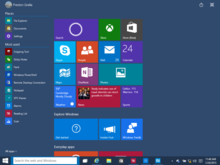Windows 10 deep-dive review: Finally, a unified operating system
The second preview release of Windows 10
begins to flesh out Microsoft's vision of an operating system that
bridges the gap between traditional PCs and touch-based tablets --
something it failed at dismally in Windows 8. More than that, the new
release reveals a single operating system that shape-shifts according to
the device it's running on, be that a PC, a tablet or a phone.
Several new features and design elements refine Windows' overall look
and feel; they also show off a significant addition, the Siri-like
digital assistant Cortana. All in all, this version of Windows 10 is
still not a finished operating system, but it's shaping up to be a
winner.
The Start screen leaves and Continuum arrives
The return of the Start menu,
first seen in the previous
Windows 10 build, is at the core of
Microsoft's commitment to providing an operating system that works as
easily on a traditional PC as on a laptop. Microsoft made several
changes in this new release that moves it even further towards that
goal.
When I first installed this revision of Windows 10, I thought that
perhaps I had done something wrong -- maybe even grabbed the wrong
ISO file for installation. Where was the dreaded touch-oriented Start
screen? All I saw was a desktop.
Clicking the Start button or pressing the Windows button on the keyboard
brought up the new Start menu, but not the touch-oriented Start screen.
I nosed around various Windows settings to see if I could get the Start
screen back. But no setting could be found.
And that's because the Start screen has been relegated to the dustbin --
except for devices with screens smaller than eight inches. In its place
are just the desktop and the Start menu. And that's a very good thing.
http://essencewebtech.in/
